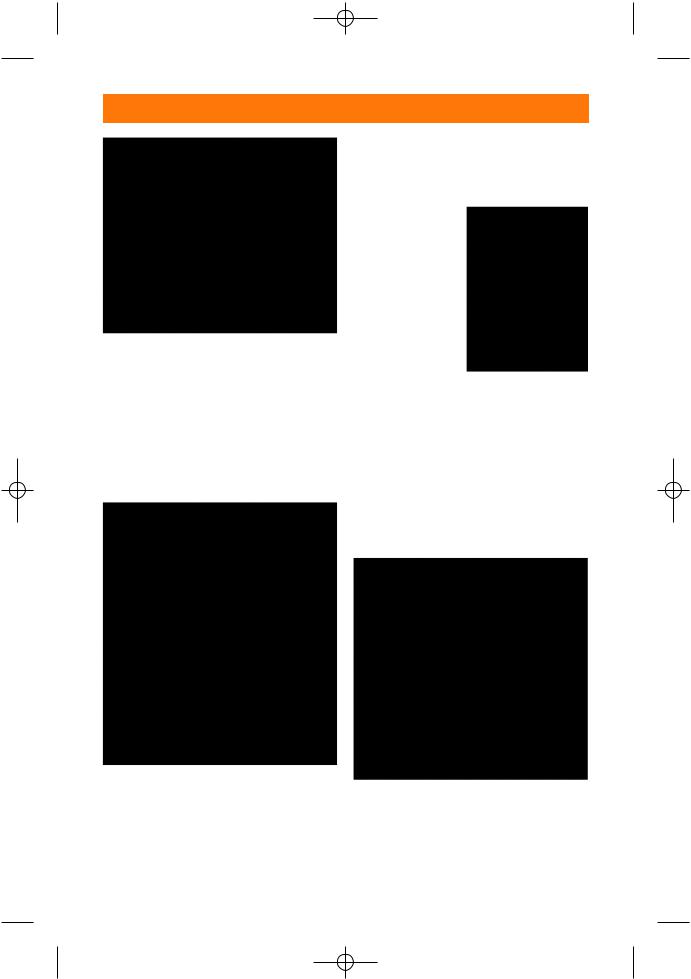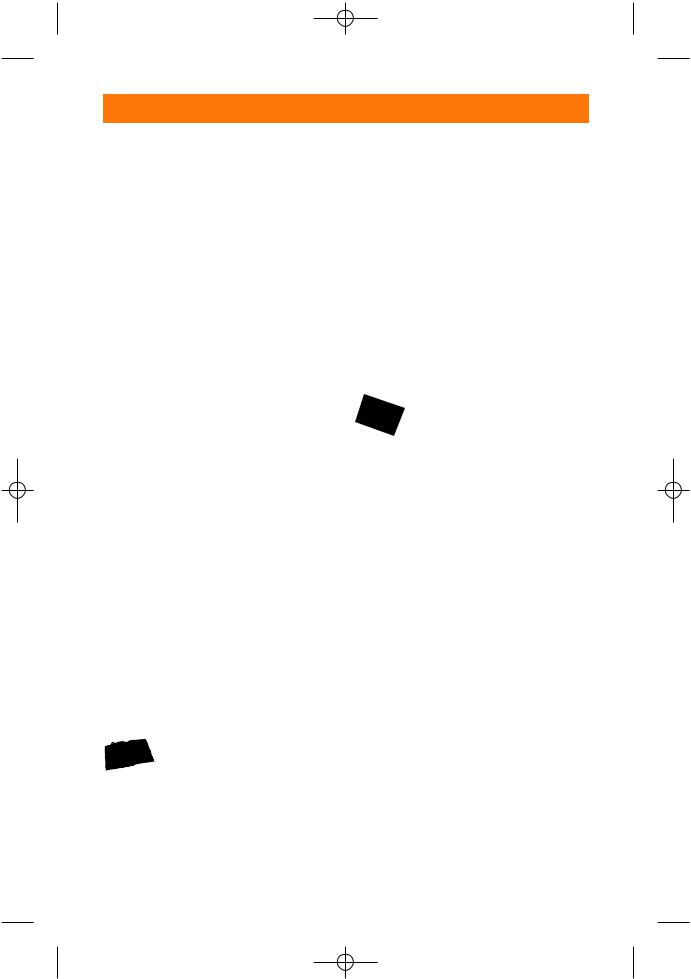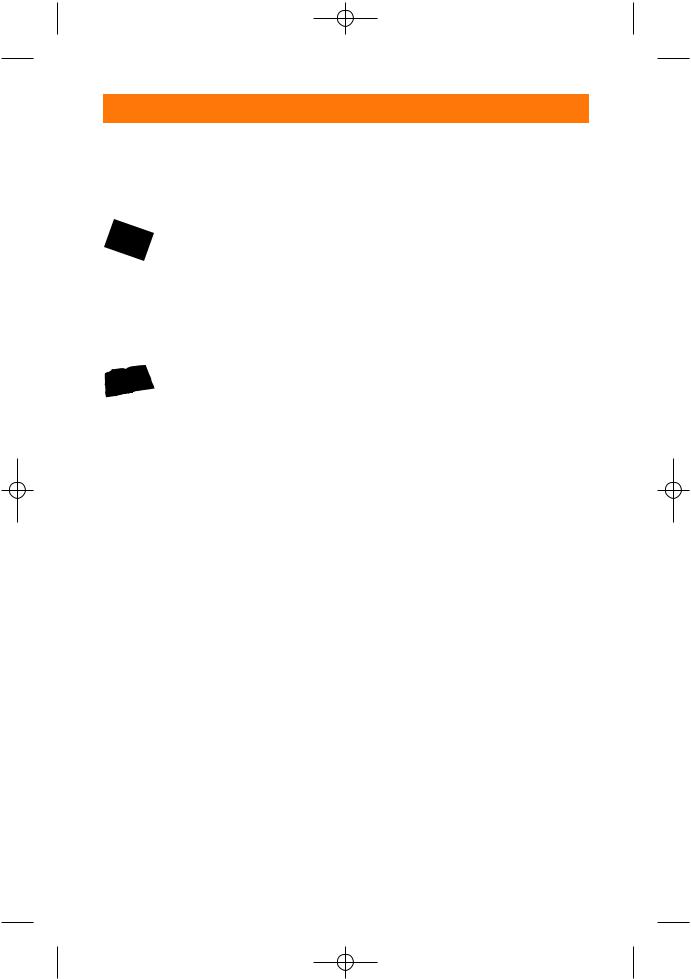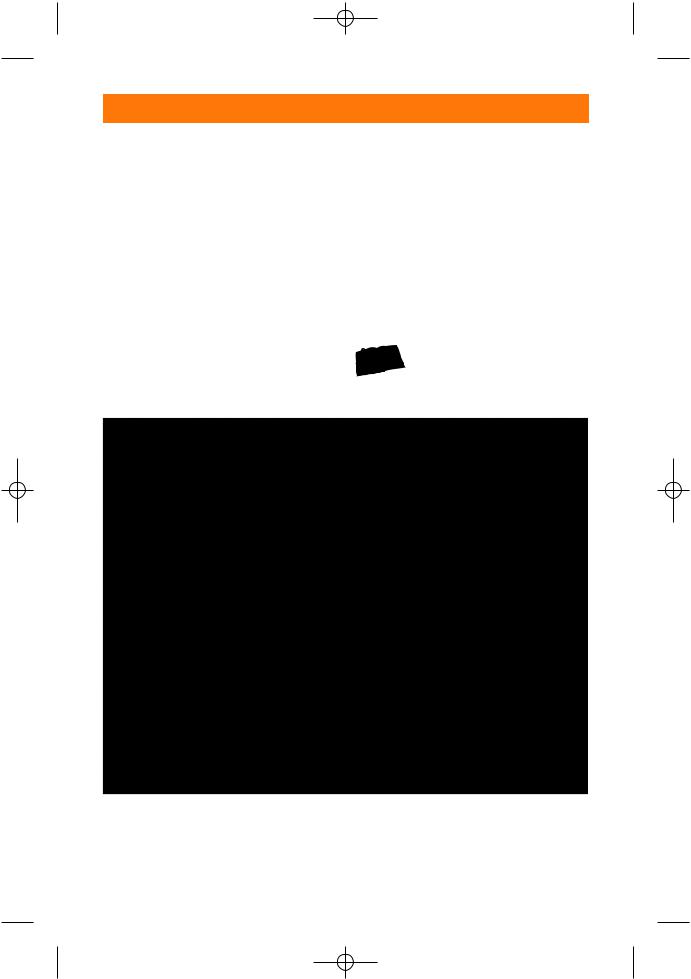
0470045272
.pdf
06_045275 ch01.qxp 11/28/06 8:28 PM Page 21
Chapter 1 Exploring the CLS 21
1.10 Wide-angle lens adaptor
External AF-assist contacts.
These contacts are for use with the optional SC-29 TTL remote cord. This allows you have the AF-assist beam when using your flash off camera.
Hot shoe mounting foot. This slides into the hot shoe on your camera body and locks down with a lever.
Flash head rotating angle scale.
Enables you to rotate the flash head horizontally left 30°, 60°, 90°, 120°, 150°, and 180°. To the
right it can be |
1.12 Flash head |
adjusted 30°, |
rotating angle scale |
60°, and 90°. |
|
Control buttons
You should know what each of the various control buttons on the SB-800 Speedlight can do to get the best results. The following sections describe them.
1.11 External AF-assist contacts and the hot |
1.13 SB-600 control panel |
shoe mounting foot |

06_045275 ch01.qxp 11/28/06 8:28 PM Page 22
22 Part I Using the Creative Lighting System
The On/Off button. Press the on/off button for about a halfsecond to turn the SB-600 on or off.
The Flash button. Press this button to test fire the SB-600 to check for output.
The Zoom button. Pressing this button changes the zoom of the flash head to adjust for different focal length lenses. It allows coverage for 24mm to 85mm lenses. 14mm coverage is achieved with the built-in wide angle diffuser.
The +/- buttons. The +/- buttons are used to change the values and settings on the SB-600 LCD screen. Depending on the flash mode the values and settings will be different.
•TTL/TTL BL. The +/- buttons allow you to set the flash compensation of the Speedlight to underexpose or overexpose from the camera’s TTL reading. The flash compensation can be set +/- 3 stops in 1⁄3 stop increments.
•M. The +/- buttons are used to set the flash exposure manually from 1⁄1 to 1⁄64. These settings are also adjustable in 1⁄3 stop increments.
•CSM. When in the custom settings mode, the +/- buttons are used to cycle through the different custom settings.
The Custom Settings Menu is covered in detail in Chapter 2 Setting up the SB-800 and SB600.
The Mode button. The mode button allows you to switch between the available flash modes. The modes available with the SB-600 are:
•TTL BL – i-TTL balanced fill flash. The exposure is determined by the camera and matched with the ambient light.
•TTL – i-TTL flash. The exposure is determined by the camera to sufficiently illuminate the subject that is focused on.
•M – full manual mode. You determine the flash power.
Note |
Depending on which camera |
|
and lens you are using, all of |
|
the SB-600 flash modes may or |
|
may not be available. |
In addition to the standard buttons on the back of the SB-600 Speedlight, there are some functions that can only be accessed by pressing two buttons at the same time:
Zoom and Mode. When the Zoom and Mode buttons are pressed simultaneously, the underexposure value from the TTL reading is displayed.
Mode and On/Off. Pressing Mode and the On/Off button together resets the SB-600 settings to factory default. You may need to do this if you’ve changed the settings and have forgotten what changes you’ve made.

06_045275 ch01.qxp 11/28/06 8:28 PM Page 23
Mode and minus. When the mode button and the - button are pressed in conjunction the control buttons are locked to prevent any accidental changes to the settings.
Note |
The lock does not affect the |
|
flash button and the On/Off |
|
button. |
Zoom and minus. Pressing the Zoom button and the – button together switches to the Speedlight to the Custom Settings Mode (CSM).
The Custom Settings Menu is covered in detail in Chapter 2.
SB-600 accessories
While the SB-600 doesn’t have as many accessories as the SB-800, it does still come with the SS-600 soft case for storage and carrying as well as an AS-19 Speedlight stand, which not only allows you mount your SB-800 to a stand or tripod, you can also use it stand the Speedlight on a flat surface.
Other Components
of the Creative
Lighting System
You have your SB-800 and SB-600 Speedlights, but what else might you need to round out your CLS? These two elements are
Chapter 1 Exploring the CLS 23
a great start, but that isn’t all there is to the Nikon Creative Lighting System. However, the components of the Nikon Creative Lighting System are hard to define as a whole. For example, the camera body is an integral part of CLS and, you can use CLS-compatible Speedlights with non-compatible camera bodies, so the line gets a little blurred.
Your D50, D70/D70s, D80, D200, D2H/D2Hs, D2X/D2Xs, or F6 camera body works great with the Speedlights. However, even if your camera is CLS compatible, that doesn’t mean it supports every available feature of the Speedlight, as explained in the earlier sections of this chapter. Be that as it may, if you use any of the camera bodies I’ve mentioned with any of the Speedlights in the following list, you have some, if not all, of the features of Nikon’s CLS.
SB-800 Speedlight
SB-600 Speedlight
SU-800 Wireless Speedlight commander
SBR-200 Wireless Remote Speedlight
R1C1 Close-up Speedlight commander kit
R1 Close-up Speedlight remote kit
Camera compatibility
Some camera bodies only allow certain features to be used with CLS. Table 1.1 shows which functions are supported by each different camera.

06_045275 ch01.qxp 11/28/06 8:28 PM Page 24
|
24 Part I |
Using the Creative Lighting System |
||
|
|
|
|
|
|
|
|
|
|
|
|
Table 1.1 |
|
|
|
|
Nikon CLS Camera Compatibility |
|
|
|
|
|
|
|
|
Camera |
|
|
|
|
Model |
|
|
|
|
or Series |
CLS Feature |
Details |
|
|
|
|
|
|
|
D50 |
i-TTL flash |
Available with the built-in |
|
|
|
|
Speedlight, SB-800, and SB-600 |
|
|
|
i-TTL balanced fill flash |
Available with the built-in |
|
|
|
|
Speedlight, SB-800, and SB-600 |
|
|
|
Auto aperture |
Available only with the SB-800 and |
|
|
|
|
an autofocus lens |
|
|
|
Non-TTL Auto |
Available with the SB-800 |
|
|
|
Distance priority manual |
Available with the SB-800 |
|
|
|
Wide Area AF-assist illuminator |
Available with the SB-800, SU-800 |
|
|
|
|
and SB-600 |
|
|
D70/D70s |
i-TTL flash |
Available with the built-in |
|
|
|
|
Speedlight, SB-800, and SB-600 |
|
|
|
i-TTL balanced fill flash |
Available with the built-in |
|
|
|
|
Speedlight, SB-800, and SB-600 |
|
|
|
Auto aperture |
Available only with the SB-800 and |
|
|
|
|
an autofocus lens |
|
Non-TTL Auto Distance-priority manual
Built-in Speedlight acts as a wireless remote commander
Flash Value (FV) lock
Wide Area AF-assist illuminator
Available with the SB-800
Available with the SB-800
Available with the SB-800, SU-800 and SB-600
D200 |
i-TTL flash |
Available with the built-in |
|
|
Speedlight, SB-800 and SB-600 |
|
Auto aperture |
Available only with the SB-800 and |
|
|
a CPU lens |
|
i-TTL balanced fill flash |
Available with the built-in |
|
|
Speedlight, SB-800 and SB-600 |
|
Non-TTL Auto |
Available with the SB-800 |
|
Distance priority manual |
Available with the SB-800 |
|
Built-in Speedlight acts as a |
|
|
wireless remote commander |
|
|
|
|

06_045275 ch01.qxp 11/28/06 8:28 PM Page 25
|
|
|
Chapter 1 Exploring the CLS 25 |
|
|
|
|
|
|
|
|
|
|
|
|
Camera |
|
|
|
|
Model |
|
|
|
|
or Series |
CLS Feature |
Details |
|
|
|
|
|
|
|
|
Flash Value (FV) lock |
|
|
|
|
Auto FP high-speed sync |
Available with the SB-800 and |
|
|
|
|
SB-600 |
|
|
|
Wide Area AF-assist illuminator |
Available with the SB-800, SU-800 |
|
|
|
|
and SB-600 |
|
|
D2X/D2Xs and |
i-TTL flash |
Available with the SB-800 and |
|
|
D2H/D2Hs |
|
SB-600 |
|
|
|
Auto aperture |
Available with the SB-800 |
|
|
|
i-TTL balanced fill flash |
Available with the SB-800 and SB-600 |
|
|
|
Non-TTL Auto |
Available with the SB-800 |
|
|
|
Distance priority manual |
Available with the SB-800 |
|
|
|
Flash Value (FV) lock |
Available with the SB-800 and SB-600 |
|
|
|
Auto FP high-speed sync |
Available with the SB-800 and SB-600 |
|
|
|
Wide Area AF-assist illuminator |
Available with the SB-800, SU-800 |
|
|
|
|
and SB-600 |
|
|
|
|
|
|
Even though each camera doesn’t offer full functionality of the CLS features that each Speedlight offers, there are some caveats, as the next sections explain.
D50
With the D50, just because you can’t use the built-in Speedlight as a remote commander doesn’t mean you can’t use advanced wireless lighting. The SB-800 or the SU-800 can be used as the commander for wireless remote Speedlights.
D70/D70s
Although the D70/D70s does allow you to use the built-in Speedlight as a commander, it is somewhat limited. When used as a
commander, the built-in Speedlight does not produce enough light to add to the exposure (this can be good or bad). It allows you to use as many remote Speedlights as you need, but all of the remote units can be used as only one group. Therefore, any exposure compensations you want to make has an effect on all of the Speedlights in the group.
Considering the price of the D70/D70s, this is still an amazing and useful feature. Being able to command even one off-camera Speedlight without the purchase of any additional accessories (other than camera and flash) is a great deal.

06_045275 ch01.qxp 11/28/06 8:28 PM Page 26
26 Part I Using the Creative Lighting System
There are ways to lessen the exposure of one Speedlight in a group, such as moving it further away from the subject. The other drawback to using the D70/D70s built-in Speedlight as a commander is that it only allows you the option of using one channel. When using the Advanced Wireless Flash different channels can be used to transmit the information to the remote Speedlights. Therefore, in a competitive shooting environment, if someone near you is using the D70 to fire an off-camera flash, their flash will set off yours and vice-versa. As with the D50, when used in conjunction with an SB800 or SU-800 the full range of advanced wireless lighting options are available including access to multiple channels.
While the D70/D70s do support FV lock, to gain this control you need to access the camera’s Custom Settings Menu. In the CSM you can select the AF/AE lock button to act as the FV lock when a Speedlight is attached.
D200
Like the D70, the D200’s built-in Speedlight can be used as a wireless remote commander. The D200’s built-in Speedlight is a lot more flexible than that of the D70. It allows you to use any number of Speedlights in two groups on four channels. The D200 also allows you the option of using the built-in Speedlight to add to the exposure when acting as a commander.
To achieve the FV lock feature, the D200’s function button must be set in the camera’s Custom Settings Menu.
The D200 offers the full range of CLS features when used with the SB-800 and a CPU lens, with the added benefit of a builtin wireless commander — something that
the D2-series, which is much more expensive, does not provide. With any camera in the D2 series you have to use either an SU800 or an SB-800 to use the advanced wireless lighting.
D2X/D2Xs and D2H/D2Hs
You are in luck with the D2 series of cameras when using the SB-600 or SB-800 Speedlights. Not only are they the top of the Nikon camera line, they support all available functions of the SB-600 and SB-800.
SU-800 Commander
A Commander unit is what tells the remote Speedlights when to fire. It also reads the data provided by the remote Speedlights pre-flashes and relays the information to the camera body for use in setting the exposure levels.
The SU-800 is an infrared wireless commander for the Nikon Creative Lighting System. It functions in much the same way as the SB-800 does in Commander mode except that it doesn’t emit any visible light. The SU-800 Commander has four independent channels, so if you are working near other photographers you can work on different channels so someone else’s SU800 Commander won’t set off your flashes.
It slides into the hot shoe of your camera like any other Speedlight and is used to wirelessly control the SB-800, SB-600, or SBR-200 flashes. Each channel can be used to control up to three groups of flashes. From the SU-800 or SB-800 you can control the output of each group individually. You can set each group to TTL, A, or M in order to fine-tune the lighting to suit your needs.

06_045275 ch01.qxp 11/28/06 8:28 PM Page 27
SBR-200 Speedlight
The SBR-200 is a dedicated macro Speedlight. With macro flash photography it’s best to get your flash on axis, or on the same level as the subject. In macro photography, your lens is usually very close to your subject, which ends up blocking the light from an on-camera shoe-mounted flash. This is where lens-mounted flashes come in.
The SBR-200 Speedlight is attachable to your lens via the SX-1 attachment ring. The SX-1 is sold separately from the SBR-200, or you can buy a kit that includes it. Nikon offers two versions of the kit:
Chapter 1 Exploring the CLS 27
R1C1 kit. This kit includes two SBR-200 Speedlights, an SU-800 Commander, and the SX-1 attachment ring.
R1 kit. This kit includes two SBR-
200 Speedlights and the SX-1 attachment ring.
The SBR-200 can’t be mounted to a hot shoe and fired from the camera. It can only be controlled with the SU-800, the SB-800, or by the on-camera Speedlights of the D200 and the D70/D70s.
More macro lighting techniques are covered in Chapter 6.
1.14 Nikon D200 with SU-800 commander with two SBR-200 macro Speedlights

06_045275 ch01.qxp 11/28/06 8:28 PM Page 28

07_045275 ch02.qxp 11/28/06 8:24 PM Page 29
Setting Up
the SB-600
and SB-800
This chapter covers how to set up your Speedlights for various types of use. I discuss the different flash settings and offer suggestions on when to use them. You also learn
how to set up your Speedlights for wireless use and how to set the zoom head for a specific lens.
Power Requirements
The power requirements for the SB-800 and the SB-600 are the same: four AA sized batteries. Having ample batteries for your Speedlight is very important. What’s the use in having a wireless portable studio when your batteries die on you? You want to carry at least one extra set of batteries for each Speedlight you have.
If you’re going to be using your Speedlights a lot, you may want to check into purchasing rechargeable batteries. The initial investment is a little more than standard alkaline batteries, but you make it back easily when you don’t have to pay several dollars for batteries every couple of days. I recommend buying two sets of rechargeable batteries for each Speedlight, which is worth it the long run. You don’t want to have to stop in the middle of a shoot to run down to a convenience store to buy second-rate batteries for twice the normal price. Trust me, I’ve been there. I always have plenty of spare batteries with me now.
Five different types of AA batteries are available for use in Nikon Speedlights that fall into two categories.
C 2H A P T E R
In This Chapter
Power requirements
Flash modes
Setting up for the
Creative Lighting
System

07_045275 ch02.qxp 11/28/06 8:24 PM Page 30
30 Part I Using the Creative Lighting System
Non-rechargeable
If you are not ready to invest a set or two of rechargeable batteries for your Speedlights, you should consider your choices within the non-rechargeable variety. There are three types to choose from.
Alkaline-manganese. These are your everyday, standard type of battery, alkaline batteries are available nearly everywhere from your local gas station to high-end camera shops. There can be differences in quality depending on the manufacturer. When buying these types of batteries, I suggest purchasing the batteries that specify they are for use with digital cameras. These batteries usually last longer than the cheaper brands.
Lithium. Lithium batteries cost a little more than standard alkaline batteries, but they last a lot longer. You can find lithium batteries at specialty battery shops and some camera shops have them in stock.
Nickel. While these types of batteries are listed in the SB-600 and SB-800 user’s manual as being one of the acceptable types of batteries to use, it is very difficult to find them. I have never come across any when looking for them.
Rechargeable
Rechargeable batteries do require more of an initial investment, but you easily get your money back in what you save by not having to buy disposable batteries often. There are
two types of rechargeable batteries to choose from for your Speedlights.
NiCd. Nickel-cadmium batteries are the most common type of rechargeable batteries. You can find NiCd batteries pretty easily. Department stores usually sell them along with a charger for under twenty dollars. Also, you can usually find them at most camera stores. While NiCd batteries are rechargeable, they don’t last forever. After time they hold less and less of a charge until they’re finally depleted. If the battery is repeatedly charged when it has not been fully exhausted, the life of the NiCd is even shorter. For example, if you come home from a shoot and your battery was only used to half of its capacity, you likely place it in the charger for your shoot tomorrow. After doing that a few times, the battery remembers that it only charges to half power, which is called battery memory. Some manufacturers, however, claim that battery memory does not exist.
Ni-MH. Nickel Metal Hydride batteries are the most expensive type of batteries, but as the saying goes, “you get what you pay for.” AA NiMH batteries have two to three times the capacity of AA NiCd batteries, therefore they last longer on a single charge than NiCd batteries do, and the battery memory problem is not as significant. You can find Ni-MH batteries in specialty battery shops.
